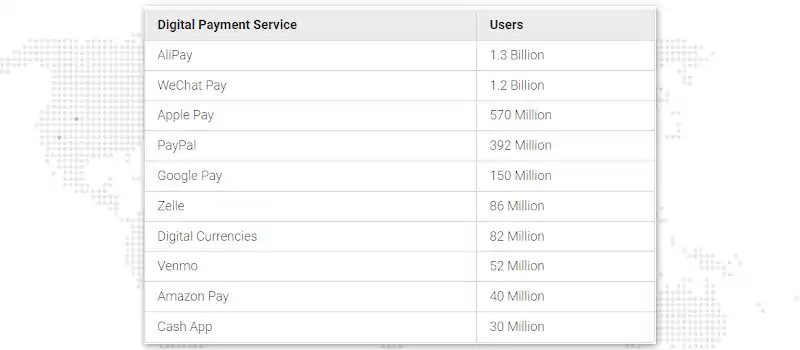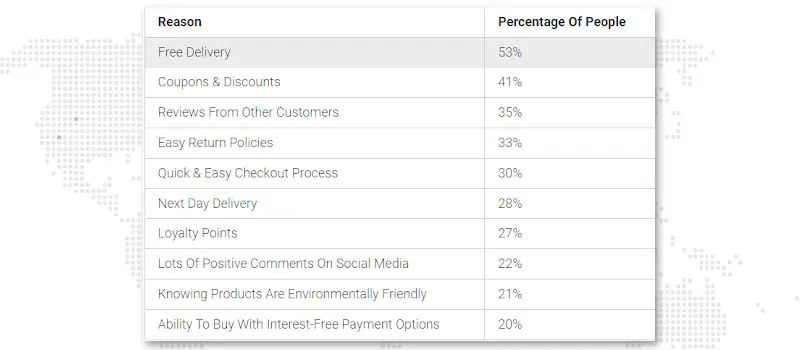
In the midst of the pandemic, online retail experienced a dramatic spike in business. As individuals around the world began spending more time at home, buying online quickly became a popular habit; therefore, e-commerce experienced unprecedented growth on all fronts.
However, there is a single issue on everyone's mind.
As we recover from the pandemic, will online shopping continue to expand?
The more you know about the eCommerce industry, the more you can keep an eye on your eCommerce website and make the necessary modifications if you're trying to sell things online. Here we present the most fascinating e-commerce statistics that will be important to know in 2024.
Worldwide, there are between 12 and 24 million online stores, and that number is growing rapidly.
Don't be alarmed if these figures make you think competition is fierce. Only about 1 million of these sites generate annual revenue of $1,000 or more, so there is a huge amount of untapped potential.
And as it becomes simpler for anyone to build an eCommerce site, more and more people are turning to online retail as a means to supplement their income. Now that you have an understanding of the scope of the eCommerce market and the number of people making money from it, it's time to look into some key e-commerce stats.
Looking for an eCommerce Web Designing Company?

While the United States certainly reaps the benefits and features of e-commerce websites; it isn't the only country to do so. Its consequences can be seen in other nations as well. There are areas that expect to increase their income significantly in the coming years.
Let's take a look at the numbers and trends of international online shopping.
Therefore, it is imperative that e-commerce enterprises get ready and increase their mobile sales efforts.
With the data presented here, it is clear that the expansion of online shopping has been phenomenal and shows no signs of slowing down. You should use the information to inform decisions about your own business.
Hence, without further ado, let's have a look at some crucial e-commerce stats.


The implementation of email marketing best practices for lead generation and client relationship management is highly recommended. Providing engaging content for each stage of the client journey is the primary reason why email campaigns in the B2B eCommerce sector are so effective.

Including social media for eCommerce in your digital marketing plan can significantly impact your brand's bottom line. And it's one of the best methods to leverage the persuasive way to increase revenue and audience size in your online venture.

JanBask is the eCommerce website development company you need. We provide website designing and development, web hosting services, domain registration, search engine marketing, e-commerce solutions, and other eCommerce services to help your business succeed online.
The success of an online store depends on the site's ability to be accessed easily from mobile devices. If you're not investing in mobile marketing, you're not caring about the vast majority of your prospective clientele. Here are some e-commerce statistics worldwide that will shed some light on the topic.

All your customers' transactions will take place in the online shopping cart.

It's no secret that major marketplaces and platforms control the vast majority of the online retail industry.
The top two providers in each field are detailed below.
The WordPress plugin WooCommerce facilitates online sales. It has the potential to transform your WordPress site into a powerful and feature-rich e-commerce facility.
How common is it?
Almost everyone has heard about Shopify by now.
As an established e-commerce platform, Shopify has experience dealing with massive amounts of traffic. Shopify's success can be attributed in part to the platform's simplicity when it comes to making professional-looking online shops.
The popularity of the Shopify platform can be attributed in part to its many useful apps.
JanBask is an eCommerce development company that can help you design and develop eCommerce website designs. We are a team of experts with the skill set to build the perfect e-commerce platform for your business.
How do brick-and-mortar stores fare in comparison to their virtual counterparts? There is no doubt that online shopping is dominating the market. However, some still prefer to shop in-store, particularly for certain categories of goods.
People's shopping habits shifted after the outbreak. Users today typically choose to shop online from the convenience of their own homes.
The convenience of shopping online proved superior to traditional methods.
Looking at retail expansion in 2020, the majority of sales are expected to come from online shopping. In that time frame, e-commerce accounted for 74.6 percent of total sales growth.
In contrast, physical store sales will only contribute 2.1% that year. That's roughly the same growth rate that shops saw in the year prior to the outbreak.
Many consumers will continue to favor brick-and-mortar stores even as online shopping grows in popularity. However, it is obvious that more and more consumers are opting to shop online. Consequently, it is necessary for you to design a plan that emphasizes the use of the Internet for retail needs.
When it comes to building eCommerce websites, some people might think it is a simple task. However, building an eCommerce site is a complex and difficult project, and it is advisable to take the help of an eCommerce website design agency to do so.
Only around a quarter of shoppers would rather not buy anything online.
About one-quarter of shoppers have admitted they would rather buy something in a store than online. The argument advanced for this practice is that it makes them feel closer to the businesses they support. Even more so for buyers in the age group of 18–25.
In terms of clothing and apparel, 59% of millennial consumers prefer to shop in physical stores.
While developing a global, multichannel e-commerce strategy may seem daunting, focusing on a few key areas will increase the likelihood of your success.
Here are some key points of emphasis:

Currency conversion and managing discounts are two challenges faced by online stores that sell internationally. As for the former, you should consider how people in your target country feel about prices. When running sales, companies should consider more than just pricing alone to gauge customer response. Three to five percentage points can be added to total revenue and profile views by linking pricing and promotions efficiently and productively.
You should have a credit/debit card processor like Stripe, mobile wallet choices like Apple Pay and Google Pay, and a buy now, pay later (BNPL) option, at the very least, for international e-commerce.
Providing excellent service to customers is crucial in every market. About half of all online shoppers value good customer support. Phone, email, and live chat are typical customer service communication channels in most nations.
Consideration of the means through which your customers will receive their purchases is crucial, as these methods are likely to be quite pricey. Therefore, it is important to consider how friction might be reduced in international transportation. This may entail investigating potential discounts with shipping companies, providing estimated delivery times, gathering information on applicable taxes, or even deciding not to sell particular items in certain nations.
While consumers remain willing to spend, inflation is putting pressure on even the most well-known international businesses. Thus, when engaging in cross-border e-commerce, it is important to take into account the influence of inflation in various nations.
As a result of this worry, it could be beneficial to look into the inflation rates of the nations you plan to sell to and possibly adjust your price strategy based on what you find.
The COVID-19 epidemic significantly impacted global e-commerce trends. The sudden closure of traditional retail outlets resulted in a stampede of consumers to the internet to make their purchases. Some estimates put the pandemic's impact on the rise of online shopping at a five-year acceleration.

Online purchases from mobile devices, such as smartphones or tablets, are known as m-commerce. Over the next five years, m-commerce will explode. Mobile shopping has been simplified by developments such as branded shopping apps, 5G connectivity, and social shopping.
Exactly what are their major worries?
Exciting developments have taken place in various aspects of advertising in recent years, including the availability of new marketing channels.
With the advent of shopping tools on social media platforms like Facebook and Instagram and, more recently, TikTok, social commerce has been gaining attention for the past five years.

The rapid growth of China's online marketplace can be attributed to a few key factors:
Live commerce is just starting to gain traction as a marketing strategy in other nations. Twenty percent of American online buyers have experienced live commerce, while another 34 percent have either not experienced it themselves but are familiar with it from hearing about it.
As a result of COVID-19's disruption of supply chains around the world, many businesses have prioritized either strengthening their supply chain to withstand disruptions better or developing strategies to prevent disruptions and swiftly restore services when they do occur. The experts agree that we won't see a return to normal until at least 2023. When they do, the global logistical network will be more susceptible to political unrest, natural calamities, and regulatory shifts than it was before the pandemic.
PayPal found that 57% of respondents were already making international purchases. Almost half of those surveyed had recently made an international purchase.
Over two-thirds of English-speaking consumers in a survey reported they would not purchase from a site that was not translated into English. This figure increased to 41% and 36% in the Japanese and South Korean markets, where international trade was the least common.
Beyond Google Translate, using a local language for your website can make or break international sales. The effect is positive from the initial contact with the company till the customer pays.
Create a site that stands out with our expert web design services. Get the best eCommerce web design services on the market today with JanBask. We offer professional eCommerce development services for companies that want to set up an online store and increase their revenue. Our experts are trained in the latest web development and programming technologies, with an emphasis on SEO and conversion optimization.
The use of digital payment systems is becoming increasingly common.
As a result, many people have taken advantage of the option to make purchases online without actually pulling out their credit cards. The use of digital payment methods is becoming increasingly popular because of the increased safety they provide for online transactions.
There are two primary methods of making digital transactions, and they are
Using a mobile device in conjunction with a credit or debit card to make a purchase.
A global average of 49% of consumers routinely use digital payments for online shopping and purchasing.
Common online payment options include:

Customers and businesses in the United States are increasingly using mobile payment services like Apple Pay and Google Pay to transact business online. Online merchants accept a variety of payment options, but Visa, MasterCard, and PayPal remain the most popular. In reality, Visa and Mastercard are accepted by practically every online store there is. The vast majority, 72%, are PayPal-friendly.
What time of day do most individuals make their internet purchases?
Most people visualize someone sitting at their kitchen table with a computer, surfing the web. We get slightly different outcomes:
Unless shipping is free, most individuals will not make an online buy. Since online shopping is rapidly becoming the standard, consumers now anticipate that all purchases will be shipped at no cost to them. Yet, there are a plethora of additional benefits to doing so. Pay attention to the following e-commerce statistics if you own an online store and are trying to boost sales.
In today's world, there are several advantages to shopping online, the most popular of which are:

Interestingly, the lack of free shipping is the primary reason why customers don't complete their online purchases. However, the availability of free shipping is the top incentive for consumers to shop online.
Consider implementing free shipping as an incentive for customers to shop at your online store if you haven't already. More than a third of shoppers will check the lowest available online pricing while physically present in a store.
What’s more?
More than 25% more money may be made and over 40% more money can be made from customers spending more than they had anticipated thanks to personalized content.
The use of influencers in advertising has become common practice for online retailers and brands worldwide. Why?
Simply put, it accomplishes its intended purpose.
Just one in eight people will spend more on a product just because an influencer or celebrity is endorsing it. This rises to 22% for buyers between the ages of 26 and 35.
When a popular person endorses a product, young people are more likely to buy it. There's more, though. By 2022, the influencer marketing market is predicted to be worth more than $16.4 billion. This year, 17% of e-commerce businesses will invest more than 50% of their marketing budget in influencer marketing initiatives.
When people in the United States try to decide between two options, they often turn to social media to read user reviews. The reviews of others are important to them because they want to know what to expect from a product before they buy it.
Despite the growth of social media as a channel for online purchases, most consumers (57%) still favor visiting the store's website. Only 18.7% of customers made a purchase via social networking apps. Over the next three years, these figures are likely to shift dramatically.
1. What is the size of the international online retail industry?
Online retail sales are expected to reach $20 billion by 2028, up from $7 billion in 2022, as reported in The Global and United States E-commerce Market Report and Forecast.
2. How can I launch an international online store?
First, identify the overseas markets that will be most beneficial to your company's expansion.
Two, learn about the preferences of your intended market in terms of things like how they like to make purchases.
Third, Formulate an entry strategy for the market.
3. What role does online shopping play in a business?
E-commerce has the potential to boost international trade, simplify commercial transactions, and inform companies about consumer preferences.
Finally, we have compiled all the most recent data about e-commerce that you should consider. Use these numbers to foresee the future of e-commerce and adjust accordingly. All the foregoing e-commerce industry statistics, studies, and developments point to the fact that international online trade is no longer a luxury but a fundamental requirement. Your company's future success or failure hinges on it.
We are a leading international eCommerce website development company offering digital marketing services to help you grow your business. We create cutting-edge websites which allow businesses to harness the power of the internet.
Interested in oureCommerce Website Development Company?

K
I had never imagined this market would be so big and significant.
A
I cannot image that in the next 50 years, these numbers will come to 100% of shopping happening online.
G
Very insightful blog. All the details are very helpful.
J
Amazing stats on ecommerce.
P
I enjoyed reading it. Thank you for writing this piece.
B
Look at this! What an immensely useful guide of ecommerce stats. Thanks for sharing.